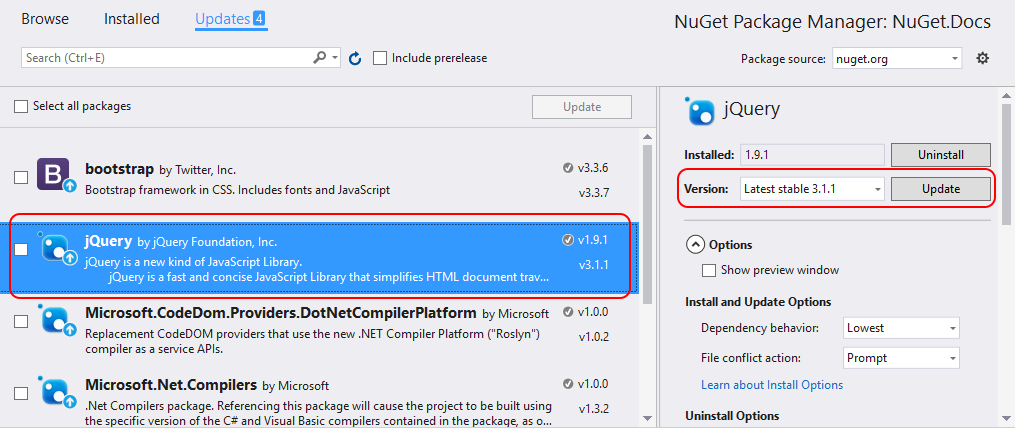
While as a developer I use multiple NuGet packages all the time in my applications, I think I’ve created only a few of my own. Here’s a solution to that which can go in C:\Projects\NuGet.It’s been a while since I had to build a NuGet package, a long while. The reason for that is probably the active package source is set to one specific feed and not the "aggregate" of all configured feeds. But all of a sudden, package restore starts complaining no package named X can be found! Customer specific components are used, as well as that framework built in-house, each on their own feed. All customer projects typically use both of these feeds. In the C:\Projects folder, we can add another configuration file which adds in another feed for every project located under C:\Projects. Every customer project can contain the following nfig: Imagine the situation where your team has a specific feed they can use for every customer project. While it is possible to put this one in a project, it's probably better to do this in the default %AppData%\NuGet\nfig: Įxample 4: feed inheritance and package restore NuGet allows configuring the default proxy credentials that should be used. Example 3: NuGet.exe keeps asking for proxy credentials Note this can be combined with the first example as well. When pushing packages to a private feed, it may happen that a developer forgets to use the -Source parameter to NuGet.exe, causing an accidental push to the default package source which is. Want to block access to and only use the private feed? Here is how: Įxample 2: help, developers are pushing our internal framework to ! sln file will add the feed to every developer's configuration (for that solution): Why would you let all your developers add the private feed used in your team feed to their NuGet configuration if a nfig can be shipped in source control? Putting the following file right next to your. Example 1: a project-specific configuration This behaviour allows some interesting setups! Let's cover a few.
All the other locations mentioned above. C:\Projects\CustomerA\AwesomeSolution\nfig. Here's another example: if you have a solution file C:\Projects\CustomerA\AwesomeSolution\AwesomeSolution.sln, all NuGet clients will load configuration values from: The interesting observation here is that all clients start with a nfig in the current directory and then walk up to the drive root, and only then are the standard files checked.This means every parent folder of a project or solution can contain additional configuration details that will be applied (note: items the file that is checked first wins). The machine-wide config file located under %ProgramData%\NuGet\nfig (this is a good one to put default configuration options in by using an Active Directory Group Policy)įull details can be found in the NuGet docs. IDE-specific configuration files, for example:. The user-specific config file located under %AppData%\NuGet\nfig. The current directory and all its parents. While the answer to this question depends on the client being used (WebMatrix does it slightly different, for example), here’s a generalized version of the three that is walked for building the configuration the client will work with. NuGet can make use of other configuration files as well! In fact, NuGet can walk an entire tree of configuration files and fetch settings from those. NuGet Package Manager Console PowerShell Referenceīy default, all NuGet clients (the command-line tool, the Visual Studio extension and the Package Manager Console) all make use of the default NuGet configuration file which lives under %AppData%\NuGet\nfig. Use TFS Online Git with MyGet Build Services. Publish NuGet Packages from Azure DevOps Pipelines. MyGet and GitHub Two Factor Authentication.  Checking NuGet package vulnerabilities with OWASP SafeNuGet. Make use of psake within your build scripts. Make use of nuget within your build scripts. Auto Trigger a MyGet Build using an HTTP POST Hook URL. Package not found during package restore. Example 4: feed inheritance and package restore. Example 3: NuGet.exe keeps asking for proxy credentials.
Checking NuGet package vulnerabilities with OWASP SafeNuGet. Make use of psake within your build scripts. Make use of nuget within your build scripts. Auto Trigger a MyGet Build using an HTTP POST Hook URL. Package not found during package restore. Example 4: feed inheritance and package restore. Example 3: NuGet.exe keeps asking for proxy credentials. 
Example 2: help, developers are pushing our internal framework to !. Example 1: a project-specific configuration.






 0 kommentar(er)
0 kommentar(er)
